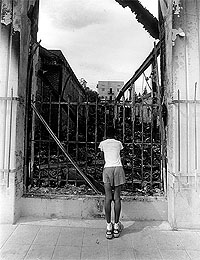
 Yesterday was the 10-year anniversary of the Los Angeles Riot. I had forgotten all about it.
Yesterday was the 10-year anniversary of the Los Angeles Riot. I had forgotten all about it.The voice from the past shot out of the speakers as I was idly channel-surfing on my car radio. NPR's Ina Jaffe was on air, recounting her tale of that night on WNYE's "Talk of the Nation", "Then I was in the First AME Church for the most of the rest of the evening, and had to figure out a way to get home when I came out of the church and realized that the corner was on fire."
I went home and listened to the program from beginning to end. It all sounds so familiar, those spring days of '92. Anna Deaver Smith talking about her epiphanies since her seminal work that came out of the ashes, "Twilight: Los Angeles, 1992", "... if one person can put herself into 46 different people�s words, then perhaps we all can go some distance about learning about our society by attempting to put ourselves into other people's shoes." John Bryant of "Operation Hope" telling his personal transformation and his work in helping to bring financial resources to South Central. Listeners called in with their testamonies. I felt that I was back in L.A. again.
Can people still get along after the fire? The question is always there - only the particular Where and When of it is surprising. And you may judge them well by how they respond. The picture I took away with me from that week was that of the well-heeled white residents of Brentwood on TV, standing warily behind barricades armed with guns and baseball bats. To me, that sums up the event - Brentwood/Simi Valley and Florence/Normandie, never the twain shall meet.
The borderline was a lot closer where I was. USC sits just south of the Downtown, in the light-industrial netherland between Downtown and South Central. The demarcation point, symbolically enough, was the Exposition Park across the street to the south, where the L.A. Olympic was held back in '84 but now mostly sat empty. There was even literally an abandoned rail track running through it. Most of the students stayed to the north, as were all the frats. South of the stadiums - Martin Luther King Boulevard, which marks the very northern tip of South Central. From the east ventures the Mexican East L.A. And cutting straight down through the middle, like a lance, is Highway 110 - all the way down to Long Beach. It was a curious mix of the barrio and the hood - old working-class neighborhood, a bit run-down and vaguely threatening, but with a scent of fiesta in the air. There was a large and brightly muraled carniceria at the entrance to my block, which drew women and children in brightly-colored clothes from the neighborhood throughout the day. Down the street a few black and brown guys hung out around the corners and in front of the laundromat, sometimes with a bottle by their side (to this day Olde English malt liquor brings back memories). Children played among the weedy sidewalk and the broken asphalt, and pieces of trash strewed here and there. At the other end of the block, a dilapidated strip mall. After nightfall, the streets cleared out.
It wasn't bad. They never bothered me as I biked to and back from school, a lone foreign student laying low in the hood. The Mexican family next door always threw great parties on weekends (barbecue, salsa and norteno), and the old Italian lady to my left would invite me over for tea after I helped her with her little orange trees in the backyard.
That night, I stayed in. I do not remember if I watched the riot breaking out on TV, or if even the TV was working. I remembered very little except that oddly, I did not feel afraid.
The next morning I ventured out. The carniceria had been looted, the door wide open, torn cartons and discarded groceries littered the sidewalk in front. So was the Ralph supermarket five blocks away. There the glass automatic doors had been smashed. From the parking lot one can only see the dark silhouette of empty, toppled shelves and water gushing out from within onto the parking lot. The perpetrators had moved on; there were only a few other dazed neighborhood people standing around outside, like myself.
I returned home and called an acquaintance out east in Monterey Park. That afternoon a car came for me and I hightailed out of there. As we left the neighborhood, I saw the little mall on the backend of the block: it had been burnt to the ground - including the Korean barbershop that I once went to.
Ten years later, I see my response and that of the fearful folks in Brentwood as the pitifully limited, although understandably self-preserving gestures that they were. When the society that you depend on everyday breaks down, it's back to every man for himself. What will you do then? Will you be ready to meet that moment, or will you succumb to the blind torrents of Fear and Rage?
I don't know, I am still working on it (wisdom is bloody slow business). But I do know this now: the next time around, I am gonna stay around a bit, and talk to my neighbors. The next time around, it'll be more fun. And that, may be the only way out.
"Welcome to the real world, kid."
(4/30 - 5/2/02, Red Bank, NJ)

 A Riot Every Day - Michael Ventura A Riot Every Day - Michael Ventura
|